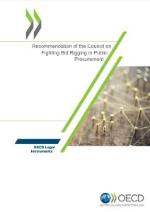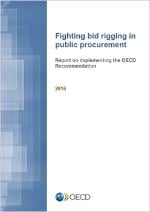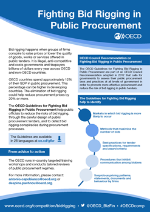Competition
Fighting bid rigging in public procurement
|
Bid rigging involves groups of firms conspiring to raise prices or lower the quality of the goods or services offered in public tenders. Although illegal, this anti-competitive practice continues to cost governments and taxpayers billions of dollars every year across OECD countries. OECD countries spend approximately 12% of their GDP in public procurement. This percentage can be higher in developing countries. The elimination of bid rigging could help reduce procurement prices by 20% or more. |
|
VIDEO: Bid rigging and competition policy explained in 7 minutes |
ONLINE FREE COURSE: Fighting Bid Rigging in Public Procurement If you wish to know what bid rigging is and how to fight bid rigging in public procurement, here is a 2-hour online course, free of charge, that can be followed at your own pace in English or Arabic. |
|
The 2012 Recommendation on Fighting Bid Rigging in Public Procurement
On 17 July 2012, the OECD Council adopted a Recommendation on Fighting Bid Rigging in Public Procurement that calls for governments to assess their public procurement laws and practices at all levels of government in order to promote more effective procurement and reduce the risk of bid rigging in public tenders. The Recommendation is a step forward in the fight against collusion in public procurement that the OECD has been leading for a long time especially through the 2009 Guidelines for Fighting bid rigging in Public Procurement and the work related to its dissemination worldwide. In 2016, the OECD issued a report to show how competition and procurement authorities have been implementing the 2012 Recommendation. Read the 2016 implementation report (also available in French).
The OECD Guidelines for Fighting Bid Rigging in Public Procurement
First adopted in 2009, the OECD Guidelines for Fighting Bid Rigging in Public Procurement are available for download in 26 different languages. They are designed to reduce the risks of bid rigging through careful design of the procurement process and to detect bid rigging conspiracies during the procurement process. |
|
|
The OECD reviews national and sector-specific public procurement regimes, to guide and support countries in combatting collusive practices. As part of these reviews or independently, the OECD develops wide-ranging capacity building programmes on fighting bid rigging in procurement, including workshops and training manuals, for public procurement, budget and internal control officials. Mexico was one of the first countries to partner with the OECD to improve its procurement practices and step up its fight against bid rigging. In January 2011, Mexico's Social Security Institute signed a Memorandum of Understanding with the OECD and Mexico's competition authority, thus becoming the first public agency to formally commit to adopt and implement the OECD Guidelines for Fighting Bid Rigging in Public Procurement. Read more about the Mexico-OECD partnership for fighting bid rigging in government contracts. Today, the OECD is currently working with Brazil, Ukraine and Peru to help them fight bid rigging. In 2019, in a partnership with Argentina, the OECD reviewed the procurement rules in public works. See our report Fighting Big Rigging in Procurement of Public Works in Argentina. In 2014, it conducted a review of Colombia’s procurement practices and provided recommendations to fight bid rigging: view our 2014 report on Fighting Bid Rigging in Public Procurement in Colombia. Lessons learnt through the OECD work on fighting bid rigging have fed into the development of the 2015 OECD Recommendation on Public Procurement and the OECD Public Procurement Toolbox.
Permanent URL: www.oecd.org/competition/bidrigging |
COUNTRY EXPERIENCES
|
Related Documents










